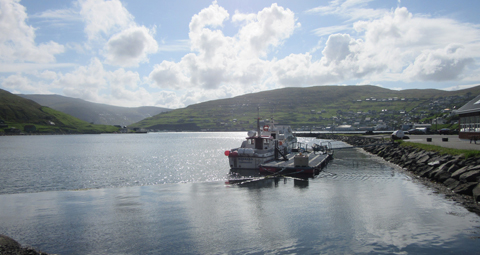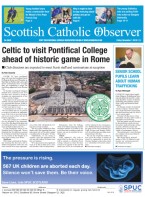November 24 | ![]() 0 COMMENTS
0 COMMENTS ![]() print
print

A voyage into the Faith of the Faroe Islands
RICHARD PURDEN visits the northern archipelago and enjoys a sense of deeply spiritual peace
IRISH monks are widely regarded as the first inhabitants of the Faroe Islands. Later Viking raiders were also said to have brought women from Scotland and Ireland. The Faroese talk of their Celtic roots with pride and many feel a genetic or romantic connection to Ireland. In a population of only 50,000, the sheep, often teetering on vertical hills, vastly outnumber people.
Among them are an estimated 240 Catholics on the islands with around a third of those Faroese. I visited St Mary’s Church in the capital of Torshavn and was surprised when an older gentleman walked past me with a copy of the Scottish Catholic Observer tucked under his arm.
Christian Gabrielsson, 70, explained that ‘Scotland is our nearest neighbour, we are both Northern European countries, and this gives us a sense of what is going on.’
He also suggested that there were ‘around 20 different nationalities coming and going due to the fact that a great many young women leave and don’t come back.’
“This has meant the Catholic Church in the Faroes has enjoyed swelling numbers in the parish due to Catholics arriving from the Philippines, Africa or Latin America,” he said.
These Catholic roots go back to 1931 when two priests including Thomas King from Scotland arrived on the Faroes to help replenish the Faith there. The current version of St Mary’s recently celebrated its 30th anniversary. Inside, there is a stained glass window of the risen Christ by Faroese artist Tróndur Patursson. Here and in other churches there are various images of Christ and the sea summoning the islands relationship with Faith and nature.
The National Museum features The Blue Deep, also by Mr Patursson, where the floor, wall and ceiling are an arrangement of blue, turquoise, red and black mosaic glass.
The islands recovered from an economic crisis in the 90s but an abundance of fishing plants and vessels are a clear sign that business is booming from natural resources.
The self-governing country is part of the Kingdom of Denmark but a national conversation about independence is gaining momentum and it continues throughout the course of the weekend with much diversity of opinion.
Subsequently it’s a short drive to the capital Tórshavn where I check-in at Hotel Hafnia. Located in the town centre, the spacious room offers a panoramic view of the harbour and the city dominated by small red wooden houses with green turfed roofs.
After an early breakfast of boiled eggs, rye bread and cured meats, I’m picked up by my tour guide Randi and we drive to Klaksvík, a town once twinned with Wick.
The islands are linked by long dark tunnels which are vital to the infrastructure—it’s hard to imagine navigating this wild landscape without them. The first was built in 1963 and others have been gradually added since.
We board the ferry to the island of Kallsoy and arrange a hike towards the remote lighthouse on Kallurin. Hiking boots and waterproofs are recommended for this part of the journey.
With not many opportunities to load up on food and drink, carrying your own provisions is advised, especially water. We opted for takeaway boxes of haddock with potato salad and carrots; this kind of fast but healthy food is typical in every supermarket and garage.
As we eat, the land begins to clear again to reveal leaping lambs in the distance, out towards the shoreline guillemots swoop on their prey. Above us a disgruntled Arctic Skua hovers menacingly above our heads and we eventually pack our things away and continue on the journey.
Despite being a popular draw with tourists, the area is not signposted and travellers are advised to tell someone where they are going as it is understandably easy to get lost and wander out into the murk.
As you approach the lighthouse, which at times feels more like an act of faith, the climb becomes vertical. A number of photographers gathered at the top of the hill waited patiently for the weather to change again.
When it eventually did the clicking began. It felt as through we standing at the world’s edge watching the bay and large chunks of black basalt rock gradually become visible.
Vestmanna translates as the Westman, meaning the Irishmen’s harbour. Hard hats are advised when embarking on this otherworldly landscape and I’m soon looking out on to an ethereal landscape sailing around jagged cliffs and tight grottoes with only puffins and sheep revealing signs of life.
Whales also appear in these waters but the closest I get is when I’m offered some from a Tupperware box along with blubber and dried fish. It’s a lot for the unfamiliar pallet to contend with. Jogvan, Randi’s spouse, suggests his grandmother’s generation were estranged from Faroese; the feeling was that to speak properly was to speak Danish as it was ‘the language of getting on and progress.’
Undoubtedly the changing attitudes towards native tongues and the identity issues around it will resonate with nationalists in Scotland. The son of a clergyman, Jogvan offers to take me to his father’s former charge.
On Sunday morning, we visit Streymore Island, there are around 75 inhabitants here. Many of them are attending a service at St Olav’s, the oldest church in the islands. Jógvan’s father once served as a minister and his son knows the community well.
Outside, a photographer, researcher and journalist are talking to the deacon, in full traditional Faroese dress. They take pictures of the ruined Magnus Cathedral, which dates back to 1300 and then we all sit down for an intimate service.
The parishioners sing unaccompanied and it’s a beautiful sound similar to the lining out still practiced in traditional Scottish Presbyterian churches and featured in Loretta Lyn’s biopic The Coalminer’s Daughter.
Although I was unaware of the content, it was a peaceful way to spend a Sunday morning. There is also a portrait in the church by Sámuel Joensen-Mikines (1906–1979) of Christ walking on water and appearing to the Apostles. The effect of the painting makes the image almost shimmer.
Although the rain was lashing and wind was howling, I wasn’t complaining—the air was fresh and I was returning home feeling a sense of peace and blessed by this deeply spiritual place.










